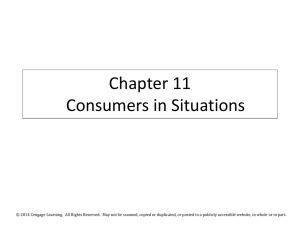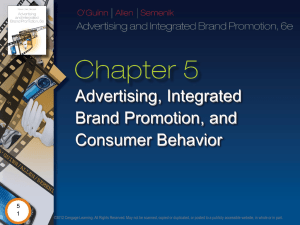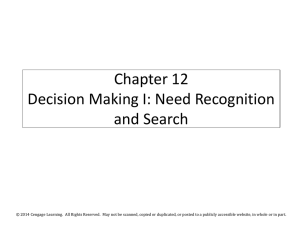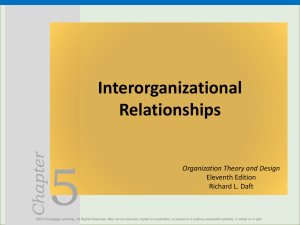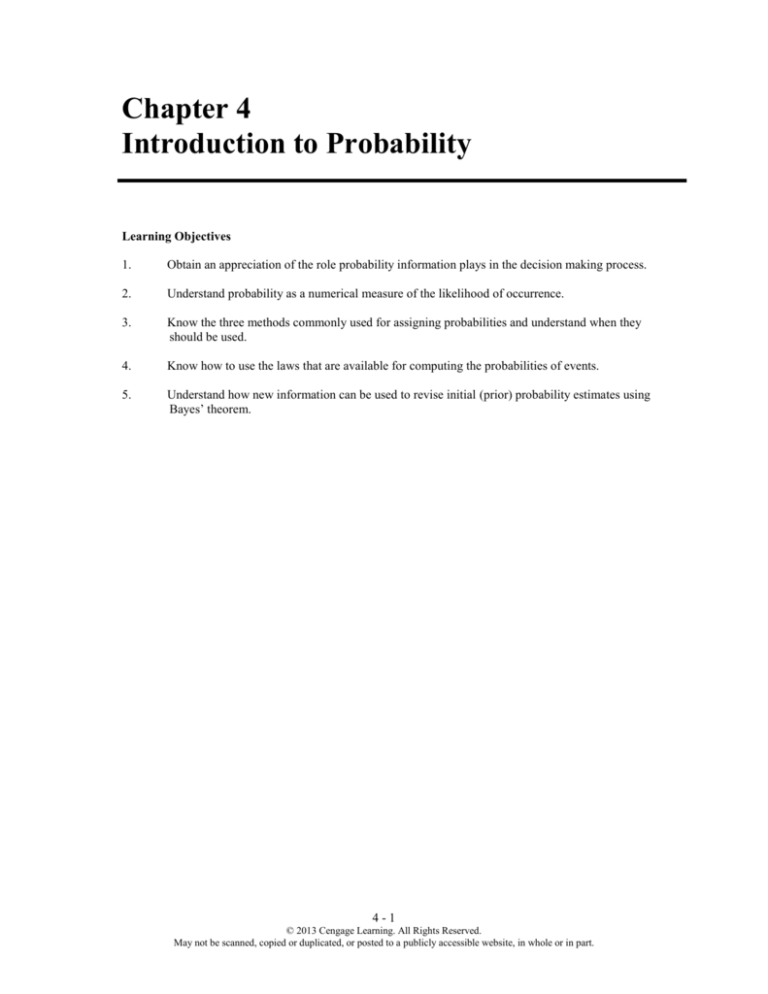
Chapter 4
Introduction to Probability
Learning Objectives
1.
Obtain an appreciation of the role probability information plays in the decision making process.
2.
Understand probability as a numerical measure of the likelihood of occurrence.
3.
Know the three methods commonly used for assigning probabilities and understand when they
should be used.
4.
Know how to use the laws that are available for computing the probabilities of events.
5.
Understand how new information can be used to revise initial (prior) probability estimates using
Bayes’ theorem.
4-1
© 2013 Cengage Learning. All Rights Reserved.
May not be scanned, copied or duplicated, or posted to a publicly accessible website, in whole or in part.
Chapter 4
Solutions:
1.
Number of experimental Outcomes = (3)(2)(4) = 24
2.
6 6!
6 5 4 3 2 1
20
3
3!3!
(3
2 1)(3 2 1)
ABC
ABD
ABE
ABF
ACD
P36
3.
ACE
ACF
ADE
ADF
AEF
BCD
BCE
BCF
BDE
BDF
BEF
CDE
CDF
CEF
DEF
6!
(6)(5)(4) 120
(6 3)!
BDF BFD DBF DFB FBD FDB
4.
a.
1st Toss
2nd Toss
3rd Toss
H
H
T
H
T
(H,H,T)
H
T
H
T
H
T
T
H
T
b.
(H,H,H)
(H,T,H)
(H,T,T)
(T,H,H)
(T,H,T)
(T,T,H)
(T,T,T)
Let: H be head and T be tail
(H,H,H) (T,H,H)
(H,H,T) (T,H,T)
(H,T,H) (T,T,H)
(H,T,T) (T,T,T)
c.
5.
The outcomes are equally likely, so the probability of each outcome is 1/8.
P(Ei) = 1/5 for i = 1, 2, 3, 4, 5
P(Ei) 0 for i = 1, 2, 3, 4, 5
P(E1) + P(E2) + P(E3) + P(E4) + P(E5) = 1/5 + 1/5 + 1/5 + 1/5 + 1/5 = 1
The classical method was used.
4-2
© 2013 Cengage Learning. All Rights Reserved.
May not be scanned, copied or duplicated, or posted to a publicly accessible website, in whole or in part.
Introduction to Probability
6.
P(E1) = .40, P(E2) = .26, P(E3) = .34
The relative frequency method was used.
7.
8.
No. Requirement (4.4) is not satisfied; the probabilities do not sum to 1. P(E1) + P(E2) + P(E3) +
P(E4) = .10 + .15 + .40 + .20 = .85
a.
There are four outcomes possible for this 2-step experiment; planning commission positive - council
approves; planning commission positive - council disapproves; planning commission negative council approves; planning commission negative - council disapproves.
b.
Let p = positive, n = negative, a = approves, and d = disapproves
Planning Commission
Council
a
(p, a)
d
p
(p, d)
n
a
.
(n, a)
d
(n, d)
9.
50
50!
50 49 48 47
230,300
4
4!46!
4 3 2 1
10. a.
Using the table provided, 94% of students graduating from Morehouse College have debt.
P(Debt) = .94
b. Five of the 8 institutions have over 60% of their graduates with debt.
P(over 60%) = 5/8 = .625
c. Two of the 8 institutions have graduates with debt who have an average debt more than $30,000.
P(more than $30,000) = 2/8 = .25
4-3
© 2013 Cengage Learning. All Rights Reserved.
May not be scanned, copied or duplicated, or posted to a publicly accessible website, in whole or in part.
Chapter 4
d.
P(No debt) = 1 - P(Debt) = 1 - .72 = .28
e. This is a weighted average calculation. 72% graduate with an average debt of $32,980 and 28%
graduate with a debt of $0.
Average debt per graduate =
11. a.
.72($32,980) .28($0)
= $23,746
.72 .28
Total motorcyclists = 350 + 170 = 520
P(DOT-Compliant Helmet) =
350
.6731
520
b.
Yes, the overall probability has been increasing from .48 five years ago, to .63 one year ago, and is
now approximately .67. The probability that a motorcyclist wears a DOT-compliant helmet appears
to be increasing.
c.
Northeast:
96
.6076
158
Midwest:
86
.6667
129
South:
92
.6525
141
West:
76
.8261
92
The West region shows the highest probability (.8261) of DOT-compliant helmet use.
12. a.
Use the counting rule for combinations:
55
55!
(55)(54)(53)(52)(51)
3, 478, 761
(5)(4)(3)(2)(1)
5 5!50!
One chance in 3,489,761
b.
Very small: 1/3,478,761 = .000000287
c.
Multiply the answer in part (a) by 42 to get the number of choices for the six numbers.
Number of Choices = (3,478,761)(42) = 146,107,962
Probability of Winning = 1/146,107,962 = .00000000684
13.
Initially a probability of .20 would be assigned if selection is equally likely. Data does not appear to
confirm the belief of equal consumer preference. For example using the relative frequency method
we would assign a probability of 5/100 = .05 to the design 1 outcome, .15 to design 2, .30 to
design 3, .40 to design 4, and .10 to design 5.
4-4
© 2013 Cengage Learning. All Rights Reserved.
May not be scanned, copied or duplicated, or posted to a publicly accessible website, in whole or in part.
Introduction to Probability
14. a.
P(E2) = 1/4
b.
P(any 2 outcomes) = 1/4 + 1/4 = 1/2
c.
P(any 3 outcomes) = 1/4 + 1/4 + 1/4 = 3/4
15. a.
S = {ace of clubs, ace of diamonds, ace of hearts, ace of spades}
b.
S = {2 of clubs, 3 of clubs, . . . , 10 of clubs, J of clubs, Q of clubs, K of clubs, A of clubs}
c.
There are 12; jack, queen, or king in each of the four suits.
d.
For a: 4/52 = 1/13 = .08
For b: 13/52 = 1/4 = .25
For c: 12/52 = .23
16. a.
(6)(6) = 36 sample points
b.
Die 2
1
2
3
4
5
6
1
2
3
4
5
6
7
2
3
4
5
6
7
8
3
4
5
6
7
8
9
4
5
6
7
8
9
10
5
6
7
8
9
10
11
6
7
8
9
10
11
12
Total for Both
Die 1
c.
6/36 = 1/6
d.
10/36 = 5/18
e.
No. P(odd) = 18/36 = P(even) = 18/36 or 1/2 for both.
f.
Classical. A probability of 1/36 is assigned to each experimental outcome.
4-5
© 2013 Cengage Learning. All Rights Reserved.
May not be scanned, copied or duplicated, or posted to a publicly accessible website, in whole or in part.
.
Chapter 4
17. a.
(4,6), (4,7), (4,8)
b.
.05 + .10 + .15 = .30
c.
(2,8), (3,8), (4,8)
d.
.05 + .05 + .15 = .25
e.
.15
18. a.
b.
P(no meals) =
11
= .0222
496
P(at least four meals) = P(4) + P(5) + P(6) + P(7 or more)
=
c.
P(two or fewer meals) = P(2) + P(1) + P(0)
=
19. a.
36 119 114 139
= .8226
496 496 496 496
30
11
11
= .1048
496 496 496
A summary of the data provided in the exercise follows:
Response
Yes
No
Unsure
Total
United States
187
334
256
777
Great Britain
197
411
213
821
Total
384
745
469
1598
Probability = 334/777 = .4299
b.
Probability = (411 + 213)/821 = .76
c.
Probability = (334 + 411) /1598 = .4662
d.
The probability that an investor in the United States thinks the government is adequately protecting
investors is 187/777 =.2407; for investors in Great Britain the probability is 197/821 = .24. The two
probabilities are almost identical; thus, there does not appear to be a difference between the
perceptions of investors in these two countries with regard to the “Yes” response.
However, in part (a) we showed that the probability that an investor in the United States does not
think the government is adequately protecting investors is.4299, or approximately .43; for investors
in Great Britain the probability is 411/821 = .5006 or approximately .50. These results show a
slightly higher probability that an investor in Great Britain will say that the government is not
protecting investors adequately.
20. a.
P(N) = 54/500 = .108
b.
P(T) = 48/500 = .096
4-6
© 2013 Cengage Learning. All Rights Reserved.
May not be scanned, copied or duplicated, or posted to a publicly accessible website, in whole or in part.
Introduction to Probability
c.
Total in 5 states = 54 + 52 + 48 + 33 + 30 = 217
P(B) = 217/500 = .434
Almost half the Fortune 500 companies are headquartered in these five states.
21. a.
b.
c.
P Fall
6455
0.1422
4535
P Transportation Incident
0.3958
4535
The Cause of Fatality that is least likely to occur is Fires and Explosions with a probability of
P Fires and Explosions
22. a.
1795
113
0.0249
4535
P(A) = .40, P(B) = .40, P(C) = .60
b.
P(A B) = P(E1, E2, E3, E4) = .80. Yes P(A B) = P(A) + P(B).
c.
Ac = {E3, E4, E5} Cc = {E1, E4} P(Ac) = .60 P(Cc) = .40
d.
A Bc = {E1, E2, E5} P(A Bc) = .60
e.
P(B C) = P(E2, E3, E4, E5) = .80
23. a.
P(A) = P(E1) + P(E4) + P(E6) = .05 + .25 + .10 = .40
P(B) = P(E2) + P(E4) + P(E7) = .20 + .25 + .05 = .50
P(C) = P(E2) + P(E3) + P(E5) + P(E7) = .20 + .20 + .15 + .05 = .60
b.
A B = {E1, E2, E4, E6, E7}
P(A B) = P(E1) + P(E2) + P(E4) + P(E6) + P(E7)
= .05 + .20 + .25 + .10 + .05 = .65
c.
A B = {E4}
d.
Yes, they are mutually exclusive.
e.
Bc = {E1, E3, E5, E6}; P(Bc) = P(E1) + P(E3) + P(E5) + P(E6)
= .05 + .20 + .15 + .10 = .50
24.
P(A B) = P(E4) = .25
Let E = experience exceeded expectations
M = experience met expectations
a.
Percentage of respondents that said their experience exceeded expectations
= 100 - (4 + 26 + 65) = 5%
P(E) = .05
4-7
© 2013 Cengage Learning. All Rights Reserved.
May not be scanned, copied or duplicated, or posted to a publicly accessible website, in whole or in part.
Chapter 4
b.
25.
P(M E) = P(M) + P(E) = .65 + .05 = .70
Let M = male young adult living in his parents’ home
F = female young adult living in her parents’ home
a.
P(M F) = P(M) + P(F) - P(M F)
= .56 + .42 - .24 = .74
b.
1 - P(M F) = 1 - .74 = .26
26. a.
Let D = Domestic Equity Fund
P(D) = 16/25 = .64
b.
Let A = 4- or 5-star rating
13 funds were rated 3-star of less; thus, 25 – 13 = 12 funds must be 4-star or 5-star.
P(A) = 12/25 = .48
c.
7 Domestic Equity funds were rated 4-star and 2 were rated 5-star. Thus, 9 funds were Domestic
Equity funds and were rated 4-star or 5-star
P(D A) = 9/25 = .36
d.
P(D A) = P(D) + P(A) - P(D A)
= .64 + .48 - .36 = .76
27.
Let
A = the event the ACC has a team in the championship game
S = the event the SEC has a team in the championship game
a.
P ( A)
10
.50
20
b.
P(S )
8
.40
20
c.
P( A S )
1
.05
20
There is a low probability that teams from both the ACC and SEC will be in the championship game.
d.
P( A S ) P( A) P(S ) P( A S ) .50 .40 .05 .85
There is a high probability that a team from the ACC or SEC will be in the championship game.
e.
P(Neither conference) = 1 P( A S ) 1 .85 .15
In this case, teams will most likely come from the Big Ten (6), Big East (4), Pac-10 (4), or Big 12
(3). Numbers shown are the number of times teams from these conferences have played in the
national championship game over the previous 20 years.
4-8
© 2013 Cengage Learning. All Rights Reserved.
May not be scanned, copied or duplicated, or posted to a publicly accessible website, in whole or in part.
Introduction to Probability
28.
Let: B = rented a car for business reasons
P = rented a car for personal reasons
a.
P(B P) = P(B) + P(P) - P(B P)
= .54 + .458 - .30 = .698
b.
P(Neither) = 1 - .698 = .302
29. a.
P(E) =
1033
.3623
2851
P(R) =
854
.2995
2851
P(D) =
964
.3381
2851
b.
Yes; P(E D) = 0
c.
Probability =
d.
Let F denote the event that a student who applies for early admission is deferred and later admitted
during the regular admission process.
1033
.4349
2375
Events E and F are mutually exclusive and the addition law applies.
P(E F) = P(E) + P(F)
P(E) = .3623 from part (a)
Of the 964 early applicants who were deferred, we expect 18%, or .18(964) students, to be admitted
during the regular admission process. Thus, for the total of 2851 early admission applicants
P(F) =
.18(964)
.0609
2851
P(E F) = P(E) + P(F) = .3623 + .0609 = .4232
Note: .18(964) = 173.52. Some students may round this to 174 students. If rounding is done, the
answer becomes .4233. Either approach is acceptable.
30. a.
P(A B)
P(A B) .40
.6667
P(B)
.60
b.
P(B A)
P(A B) .40
.80
P(A)
.50
c.
No because P(A | B) P(A)
4-9
© 2013 Cengage Learning. All Rights Reserved.
May not be scanned, copied or duplicated, or posted to a publicly accessible website, in whole or in part.
Chapter 4
31. a.
P(A B) = 0
P(A B) 0
0
P(B)
.4
b.
P(A B)
c.
No. P(A | B) P(A); the events, although mutually exclusive, are not independent.
d.
Mutually exclusive events are dependent.
32. a.
Row and column sums are shown.
U.S.
Non U.S.
Total
Car
87.4
228.5
315.9
Light Truck
193.1
148.0
341.1
Total
280.5
376.5
657.0
A total of 657.0 thousand vehicles were sold.
Dividing each entry in the table by 657.0 provides the following joint probability table.
U.S.
Non U.S.
Total
b.
Let
U=
N=
C=
L =
Car
.1330
.3478
.4808
Light Truck
.2939
.2253
.5192
Total
.4269
.5731
1.0000
U. S. manufacturer
Non U.S. manufacturer
Car
Light Truck
Marginal probabilities: P(U) = .4269 P(B) = .5731
There is a higher probability that the vehicle was not manufactured by a U. S. auto maker. In terms
of market share, non U.S. auto makers lead with a 57.3% share of vehicle sales.
Marginal probabilities: P(C) = .4808 P(L) = .5192
The light truck category which includes pickup, minivans, SUVs and crossover models has a slightly
higher probability. But the types of vehicles are fairly even split.
c.
P(C U )
P(C U ) .1330
.3115
P(U )
.4269
P( L U )
P( L U ) .2939
.6885
P(L)
.4269
If a vehicle was manufactured by one of the U.S. auto makers, there is a higher probability it will be
in the light truck category.
d.
P(C N )
P(C N ) .3478
.6069
P(N )
.5731
P( L N )
P( L N ) .2253
.3931
P(L)
.5731
If a vehicle was not manufactured by one of the U.S. auto makers, there is a higher probability it will
be a car.
4 - 10
© 2013 Cengage Learning. All Rights Reserved.
May not be scanned, copied or duplicated, or posted to a publicly accessible website, in whole or in part.
Introduction to Probability
e.
P(U L)
P(U L) .2939
.5661
P(L)
.5192
If a vehicle was a light truck, there is better than a 50-50 chance that it was manufactured by one of
the U.S. auto makers.
f.
There is a higher probability, and thus a larger market share for non U.S. auto makers. However, the
U. S. auto makers are leaders in sales for the light truck category.
33. a.
Undergraduate Major
Intended
Enrollment
Status
Business
Engineering
Other
Totals
Full-Time
0.270
0.151
0.192
0.613
Part-Time
0.115
0.123
0.149
0.387
0.385
0.274
0.341
1.000
Totals
b.
P(Business) = 0.385, P(Engineering) = 0.274, and P(Other) = 0.341, so Business is the
undergraduate major that produces the most potential MBA students.
c.
P Engineering | Full - Time =
d.
P Full - Time | Business =
e.
P Engineering Full - Time 0.151
0.246
P Full - Time
0.613
P Full - Time Business 0.270
0.701
P Business
0.385
Let A denote the event that student intends to attend classes full time in pursuit of an MBA degree,
and let B denote the event that the student was an undergraduate Business major. Are events A and B
independent? Justify your answer.
For independence, we must have that P A P B P A B ; from the joint probability table in part
(a) of this problem, we have
P(A) = 0.613
P(B) = 0.385
So P A P B 0.387 0.385 0.236
But
P A B 0.270
Because P A P B P A B , the events are not independent.
4 - 11
© 2013 Cengage Learning. All Rights Reserved.
May not be scanned, copied or duplicated, or posted to a publicly accessible website, in whole or in part.
Chapter 4
34. a.
Let O
Oc
S
U
J
=
=
=
=
=
flight arrives on time
flight arrives late
Southwest flight
US Airways flight
JetBlue flight
Given: P(O | S) = .834
P(S) = .40
P(O | S) =
P(O | U) = .751
P(O | J) = .701
P(U) = .35
P(J) = .25
P(O S)
P(S)
P(O S) = P(O | S)P(S) = (.834)(.4) = .3336
Similarly
P(O U) = P(O | U)P(U) = (.751)(.35) = .2629
P(O J) = P(O | J)P(J) = (.701)(.25) = .1753
Joint probability table
Southwest
US Airways
JetBlue
Total:
On time
.3336
.2629
.1753
.7718
Late
.0664
.0871
.0747
.2282
Total
.40
.35
.25
1.00
b.
Southwest Airlines; P(S) = .40
c.
P(O) = P(S O) + P(U O) + P(J O) = .3336 + .2629 + .1753 = .7718
d.
P(S Oc )
P(S Oc ) .0664
.2910
.2282
P(Oc )
Similarly, P(U Oc )
P(J Oc )
.0871
.3817
.2282
.0747
.3273
.2282
Most likely airline is US Airways; least likely is Southwest
35. a.
The total sample size is 200. Dividing each entry by 200 provides the following joint probability
table.
Pay Rent
Yes
No
Yes
.28
.26
.54
Buy a Car
No
.07
.39
.46
.35
.65
4 - 12
© 2013 Cengage Learning. All Rights Reserved.
May not be scanned, copied or duplicated, or posted to a publicly accessible website, in whole or in part.
Introduction to Probability
b.
Let C = the event of financial assistance to buy a car
R = the event of financial assistance to pay rent
Using the marginal probabilities, P(C) = .54 and P(R) = .35. Parents are more likely to provide their
adult children with financial assistance to buy a car. The probability of financial assistance to buy a
car is .54 and the probability of financial assistance to pay rent is .35.
P( R C ) .28
.5185
P(C )
.54
c.
P(R C )
d.
P( R C C )
e.
Financial assistance to buy a car is not independent of financial assistance to pay rent,
P( R C ) P( R) .
P( R C C ) .07
.1522
.46
P(C C )
If there is financial assistance to buy a car, the probability of financial assistance to pay rent
increases from .35 to .5185. However, if there is no financial assistance to buy a car, the probability
of financial assistance to pay rent decreases from .35 to .1522.
f.
36. a.
b.
P(C R) P(C ) P( R) P( R C ) .54 .35 .28 .61
We have that P(Make the Shot) = .93 for each foul shot, so the probability that Jamal Crawford will
make two consecutive foul shots is that P(Make the Shot) P(Make the Shot) = (.93)(.93) = .8649.
There are three unique ways that Jamal Crawford can make at least one shot – he can make the first
shot and miss the second shot, miss the first shot and make the second shot, or make both shots.
Since the event “Miss the Shot” is the compliment of the event “Make the Shot,” P(Miss the Shot) =
1 – P(Make the Shot) = 1 – .93 = .07. Thus:
P(Make the Shot) P(Miss the Shot) = (.93)(.07) = .0651
P(Miss the Shot) P(Make the Shot) = (.07)(.93) = .0651
P(Make the Shot) P(Make the Shot) = (.93)(.93) = .8649
.9951
c.
We can find this probability in two ways. We can calculate the probability directly:
P(Miss the Shot) P(Miss the Shot) = (.07)(.07) = .0049
Or we can recognize that the event “Miss both Shots” is the compliment of the event “Make at Least
One of the Two Shots”, so
P(Miss the Shot) P(Miss the Shot) = 1 - .9951 = .0049
d.
For the Portland Trail Blazers’ center, we have:
P(Make the Shot) = .58 for each foul shot, so the probability that the Portland Trail Blazers’ center
will make two consecutive foul shots is P(Make the Shot) P(Make the Shot) = (.58)(.58) = .3364.
4 - 13
© 2013 Cengage Learning. All Rights Reserved.
May not be scanned, copied or duplicated, or posted to a publicly accessible website, in whole or in part.
Chapter 4
Again, there are three unique ways that the Portland Trail Blazers’ center can make at least one shot
– he can make the first shot and miss the second shot, miss the first shot and make the second shot,
or make both shots. Since the event “Miss the Shot” is the compliment of the event “Make the Shot,”
P(Miss the Shot) = 1 – P(Make the Shot) = 1 – .58 = .42. Thus
P(Make the Shot) P(Miss the Shot) = (.58)(.42) =
.2436
P(Miss the Shot) P(Make the Shot) = (.42)(.58) = .2436
P(Make the Shot) P(Make the Shot) = (.58)(.58) = .3364
.8236
We can again find the probability the Portland Trail Blazers’ center will miss both shots in two
ways. We can calculate the probability directly:
P(Miss the Shot) P(Miss the Shot) = (.42)(.42) = .1764
Or we can recognize that the event “Miss both Shots” is the compliment of the event “Make at Least
One of the Two Shots”, so
P(Miss the Shot) P(Miss the Shot) = 1 - .9951 = .1764
Intentionally fouling the Portland Trail Blazers’ center is a better strategy than intentionally fouling
Jamal Crawford.
37.
Let C = event consumer uses a plastic card
B = event consumer is 18 to 24 years old
Bc = event consumer is over 24 years old
Given information:
P(C) .37
P(B C) .19
P(Bc C) .81
P(B) .14
a.
P(C B)
P(C B)
P(B)
but P(C B) is unknown. So first compute
P(C B) P(C) P(B C)
.37(.19) .0703
Then
P(C B)
P(C B) .0703
.5021
P(B)
.14
4 - 14
© 2013 Cengage Learning. All Rights Reserved.
May not be scanned, copied or duplicated, or posted to a publicly accessible website, in whole or in part.
Introduction to Probability
b.
P(C Bc )
P(C Bc )
P(Bc )
but P(C Bc ) and P(Bc ) are unknown. However, they can be computed as follows.
P(C Bc ) P(C)P(Bc C)
.37(.81) .2997
P(Bc ) 1- P(B) 1 .14 .86
Then
P(C Bc )
P(C Bc ) .2997
.3485
.86
P(Bc )
c.
There is a higher probability that the younger consumer, age 18 to 24, will use plastic when making
a purchase. The probability that the 18 to 24 year old consumer uses plastic is .5021 and the
probability that the older than 24 year old consumer uses plastic is .3485. Note that there is greater
than .50 probability that the 18 to 24 years old consumer will use plastic.
d.
Companies such as Visa, Mastercard and Discovery want their cards in the hands of consumers who
will have a high probability of using the card. So yes, these companies should get their cards in the
hands of young consumers even before these consumers have established a credit history. The
companies should place a low limit of the amount of credit charges until the young consumer has
demonstrated the responsibility to handle higher credit limits.
38. a.
The data table with row and column totals is shown below. Note that a total of 423,392 students
took the state mathematics exam.
Grade
3
4
5
6
7
8
Total
Met Proficiency Standards?
Yes
No
47,401
23,975
35,020
34,740
36,062
33,540
36,361
32,929
40,945
29,768
40,720
31,931
236,509
186,883
Total
71,376
69,760
69,602
69,290
70,713
72,651
423,392
The joint probability table follows. The probabilities were computed by dividing each entry in the
above table by the total number of students taking the state mathematics exam: 423,392.
4 - 15
© 2013 Cengage Learning. All Rights Reserved.
May not be scanned, copied or duplicated, or posted to a publicly accessible website, in whole or in part.
Chapter 4
Grade
Met Proficiency Standards
Yes
No
Total
3
.11196
.05663
0.16858
4
.08271
.08205
0.16476
5
.08517
.07922
0.16439
6
.08588
.07777
0.16365
7
.09671
.07031
0.16702
8
.09618
.07542
0.17159
Total
.55861
.44139
1.00000
For example, let G3 = event that a student is in the third grade and S = event that the student met the
proficiency standards on the exam. The joint probability in the Grade 3 row and the Yes column is
P(G3 S ) 47,401/ 423,392 .11196
b.
The column marginal probabilities are .55861 and .44139. The marginal probability of .55861 is the
probability that a randomly selected student met the proficiency standards on the exam and the
marginal probability of .44139 is the probability that a randomly selected student did not meet the
proficiency standards on the exam. There is a slightly better than 50-50 chance that a student met
the proficiency standards on the exam.
The row marginal probabilities of .16858, .16476, and so on show the probability that a random
selected student is in each grade. Because the number of students in each grade is approximately the
same, the probabilities are very similar. Note that the highest probability of .17159 is the probability
that a randomly selected student who took the exam is in the 8 th grade.
c.
P( S G 3)
P( S G 3) .11196
.6641
P(G 3)
.16858
Let G4 = event that a randomly student is in the fourth grade.
d.
39. a.
b.
P( S G 4)
P( S G 4) .08271
.5020
P(G 4)
.16476
P (G 3 S )
P(G 3 S ) .11196
.2004
P( S )
.55861
P (G 4 S )
P(G 4 S ) .08271
.1481
P( S )
.55861
Yes, since P(A1 A2) = 0
P(A1 B) = P(A1)P(B | A1) = .40(.20) = .08
P(A2 B) = P(A2)P(B | A2) = .60(.05) = .03
c.
P(B) = P(A1 B) + P(A2 B) = .08 + .03 = .11
4 - 16
© 2013 Cengage Learning. All Rights Reserved.
May not be scanned, copied or duplicated, or posted to a publicly accessible website, in whole or in part.
Introduction to Probability
d.
40. a.
P(A1 B)
.08
.7273
.11
P (A 2 B)
.03
.2727
.11
P(B A1) = P(A1)P(B | A1) = (.20)(.50) = .10
P(B A2) = P(A2)P(B | A2) = (.50)(.40) = .20
P(B A3) = P(A3)P(B | A3) = (.30)(.30) = .09
b.
.20
.51
.10 .20 .09
P(A 2 B)
c.
Events
A1
A2
A3
41.
P(Ai)
.20
.50
.30
1.00
P(Ai B)
.10
.20
.09
.39
P(B | Ai)
.50
.40
.30
P(Ai | B)
.26
.51
.23
1.00
S1 = successful, S2 = not successful and B = request received for additional information.
a.
P(S1) = .50
b.
P(B | S1) = .75
c.
P(S1 B)
42.
(.50)(.75)
.375
.65
(.50)(.75) (.50)(.40) .575
M = missed payment
D1 = customer defaults
D2 = customer does not default
P(D1) = .05
P(D2) = .95
P(M | D2) = .2
P(D1 ) P(M D1 )
P(M | D1) = 1
P(D1 M)
b.
Yes, the probability of default is greater than .20.
43. a.
P(D1 ) P(M D1 ) P(D2 ) P(M D2 )
(.05)(1)
.05
.21
(.05)(1) (.95)(.2) .24
a.
Let M = event that a putt is made
P(M) = 983,764/1,613,234 = .610
Note: The probability that a putt is missed is P( M C ) 1 P( M ) 1 .610 .390
4 - 17
© 2013 Cengage Learning. All Rights Reserved.
May not be scanned, copied or duplicated, or posted to a publicly accessible website, in whole or in part.
Chapter 4
b.
Let A= event that a PGA Tour player has a par putt
P( A M ) .640
P( A M C ) .203
P( M A)
c.
P( M ) P( A M )
C
P( M ) P( A M ) P( M ) P( A M )
C
(.610)(.640)
.831
(.610)(.640) (.390)(.203)
Let B = event that a PGA Tour player has a birdie putt
P( B M ) .188
P( B M C ) .734
P( M B )
d.
44. a.
P( M ) P( B M )
C
P( M ) P( B M ) P( M ) P( B M )
C
(.610)(.188)
.286
(.610)(.188) (.390)(.734)
These probabilities indicate that there is a much higher probability of making a par put than a birdie
putt. The authors of the article referenced in this exercise state that “even the best players … show
evidence of loss aversion.” In other words, PGA Tour players tend to view missing a par putt as a
loss and making a birdie putt as a gain. With regard to putting, their behavior indicates that they
prefer avoiding losses to making gains. “On average this bias costs the best golfers over $1.2 million
in tournament winnings per year.”
P(A1) = .095
P(A2) = .905
P(W | A1) = .60
P(W | A2) = .49
b.
Events
P(Ai)
P(W|Ai)
P(Ai∩W)
A1
0.095
0.60
0.05700
0.1139
A2
0.905
0.49
0.44345
0.8861
P(W) = 0.50045
1.0000
P(Ai|W)
P(A1|W) = .1139
4 - 18
© 2013 Cengage Learning. All Rights Reserved.
May not be scanned, copied or duplicated, or posted to a publicly accessible website, in whole or in part.
Introduction to Probability
c.
Events
P(Ai)
P(M|Ai)
P(Ai∩M)
A1
0.095
0.40
0.03800
0.0761
A2
0.905
0.51
0.46155
0.9239
P(M) = 0.49995
1.0000
P(Ai|M)
P(A1|M) = .0761
d.
P(W) = .50045
P(M) = .49965
45. a.
Let A = age 65 or older
P( A) 1 .835 .165
b.
Let D = takes drugs regularly
P( A D ) =
46. a.
P( A) P( D A)
C
P( A) P( D A) P( AC ) P( D A )
=
.165(.82)
.165(.82) .835(.49)
=
.1353
= .2485
.1353 .4092
Let A = a respondent owns a home
P(A) = 1249/2082 = .60
b.
Let B = a respondent aged 18 to 34 owns a home
P(B) = 117/450 = .26
c.
Let AC = a respondent does not own a home
P(AC) = 1 - P(A) = 1 - .60 = .40
d.
Let BC = a respondent aged 18 to 34 does not own a home
P(BC) = 1 - P(B) = 1 - .26 = .74
47. a.
b.
(2)(2) = 4
Let
S = successful
U = unsuccessful
4 - 19
© 2013 Cengage Learning. All Rights Reserved.
May not be scanned, copied or duplicated, or posted to a publicly accessible website, in whole or in part.
Chapter 4
Oi
l
Bond
s
S
E1
U
S
E2
U
S
E3
U
E4
c.
O = {E1, E2}
M = {E1, E3}
d.
O M = {E1, E2, E3}
e.
O M = {E1}
f.
No; since O M has a sample point.
48. a.
0.5029
b.
0.5758
c.
No, from part (a) we have P(F) = 0.5029 and from part (b) we have P(A|F) = 0.5758. Since P(F) ≠
P(A|F), events A and F are not independent.
49.
Let
I = treatment-caused injury
D = death from injury
N = injury caused by negligence
M = malpractice claim filed
$ = payment made in claim
We are given P(I) = 0.04, P(N | I) = 0.25, P(D | I) = 1/7, P(M | N) = 1/7.5 = 0.1333,
and P($ | M) = 0.50
a.
P(N) = P(N | I) P(I) + P(N | Ic) P(Ic)
= (0.25)(0.04) + (0)(0.96) = 0.01
b. P(D) = P(D | I) P(I) + P(D | Ic) P(Ic)
= (1/7)(0.04) + (0)(0.96) = 0.006
4 - 20
© 2013 Cengage Learning. All Rights Reserved.
May not be scanned, copied or duplicated, or posted to a publicly accessible website, in whole or in part.
Introduction to Probability
c.
P(M) = P(M | N) P(N) + P(M | Nc) P(Nc)
= (0.1333)(0.01) + (0)(0.99) = 0.001333
P($) = P($ | M) P(M) + P($ | Mc) P(Mc)
= (0.5)(0.001333) + (0)(0.9987) = 0.00067
50. a.
Probability of the event = P(average) + P(above average) + P(excellent)
=
b.
11 14 13
= .22 + .28 + .26 = .76
50 50 50
Probability of the event = P(poor) + P(below average)
=
4
8
.24
50 50
51. a.
Education Level
Not H.S. Graduate
H.S. Graduate
Some College
Bachelor's Degree
Beyond Bach. Degree
Total
b.
Under 25
.0571
.0667
.0381
.0120
.0039
.1777
Household Income ($1000)
25-49.9 50-74.9 75-99.9
.0469
.0188
.0073
.0929
.0682
.0358
.0713
.0634
.0441
.0284
.0386
.0350
.0112
.0173
.0168
.2508
.2064
.1390
100 or More
.0050
.0362
.0553
.0729
.0568
.2262
Total
.1351
.2997
.2721
.1870
.1061
1.0000
This is a marginal probability.
P(Not H.S. graduate) = .1351
c.
This is the sum of 2 marginal probabilities.
P(Bachelor's Degree Beyond Bachelor's Degree) = .1870 + .1061 = .2931
d.
This is a conditional probability.
e.
P(100 or More BD) .0729
.3898
P(BD)
.1870
This is a marginal probability.
P(100 or More BD)
P(Under 25) = .1777
f.
This is a conditional probability.
P(Under 25 BD)
g.
P(Under 25 BD) .0120
.0642
P(BD)
.1870
No. P(100 or More BD) .3898 which is not equal to P(100 or More) = .2262. This is also shown
by comparing the probabilities in parts (e) and (f). Household income is not independent of
education level. Individuals with a Bachelor’s Degree have a higher probability of having a higher
household income.
4 - 21
© 2013 Cengage Learning. All Rights Reserved.
May not be scanned, copied or duplicated, or posted to a publicly accessible website, in whole or in part.
Chapter 4
52. a.
Yes
No
Total
23 and Under
.1026
.0996
.2022
24 - 26
.1482
.1878
.3360
27 - 30
.0917
.1328
.2245
31 - 35
.0327
.0956
.1283
36 and Over
.0253
.0837
.1090
Total
.4005
.5995
1.0000
b.
.2022
c.
.2245 + .1283 + .1090 = .4618
d.
.4005
53. a.
.
P(24 to 26 | Yes) = .1482/.4005 = .3700
b.
P(Yes | 36 and over) = .0253/.1090 = .2321
c.
.1026 + .1482 + .1878 + .0917 + .0327 + .0253 = .5883
d.
P(31 or more | No) = (.0956 + .0837)/.5995 = .2991
e.
No, because the conditional probabilities do not all equal the marginal probabilities. For instance,
P(24 to 26 | Yes) = .3700 P(24 to 26) = .3360
54. a.
.7766
P(OKAY 30 49) 0.0907
0.2852
P(30 49)
0.3180
b.
P(OKAY 30 49)
c.
P(50 NOT OKAY)
P(50 NOT OKAY) 0.4008
0.5161
P(NOT OKAY)
0.7766
4 - 22
© 2013 Cengage Learning. All Rights Reserved.
May not be scanned, copied or duplicated, or posted to a publicly accessible website, in whole or in part.
Introduction to Probability
d.
The attitude about this practice is not independent of the age of the respondent. We can show this in
several ways. One example is to use the result from part (b). We have
P OKAY 30 49 0.2852
and
P OKAY 0.2234
If the attitude about this practice were independent of the age of the respondent, we would expect
these probabilities to be equal. Since these probabilities are not equal, the data suggests the attitude
about this practice is not independent of the age of the respondent.
e.
Respondents in the 50+ age category are far more likely to say this practice is NOT OKAY than are
respondents in the 18-29 age category:
P NOT OKAY|50+
P NOT OKAY 50 0.4008
0.8472
P 50+
0.4731
P NOT OKAY|18-29
55. a.
P(B S)
P NOT OKAY 18-29 0.1485
0.7109
P 18-29
0.2089
P(B S ) .12
.30
P(S)
.40
We have P(B | S) > P(B).
Yes, continue the ad since it increases the probability of a purchase.
b.
Estimate the company’s market share at 20%. Continuing the advertisement should increase the
market share since P(B | S) = .30.
c.
P(B S)
P(B S ) .10
.333
P(S)
.30
The second ad has a bigger effect.
56. a.
P(A) = 200/800 = .25
b.
P(B) = 100/800 = .125
c.
P(A B) = 10/800 = .0125
d.
P(A | B) = P(A B)/P(B) = .0125/.125 = .10
e.
No, P(A | B) P(A) = .25
4 - 23
© 2013 Cengage Learning. All Rights Reserved.
May not be scanned, copied or duplicated, or posted to a publicly accessible website, in whole or in part.
Chapter 4
57.
Let
A = lost time accident in current year
B = lost time accident previous year
Given: P(B) = .06, P(A) = .05, P(A | B) = .15
a.
P(A B) = P(A | B)P(B) = .15(.06) = .009
b.
P(A B) = P(A) + P(B) - P(A B) = .06 + .05 - .009 = .101 or 10.1%
58.
Let:
B = blogger
Bc = non blogger
Y = young adult (18-29)
Yc = older adult
Given: P(B) = .08 P(Y | B) = .54 P(Y | Bc) = .24
P (Y B)
P (B)
P(Y | B) =
P(Y B) = P(Y | B)P(B) = (.54)(.08) = .0432
P(Y | Bc) =
P (Y Bc )
P (Bc )
P(Y Bc) = P(Y | Bc)P(Bc) = (.24)(.92) = .2208
Blogger
Non Blogger
Total:
Young Adult
.0432
.2208
.2640
Older Adult
.0368
.6992
.7360
Total
.08
.92
1.00
b.
P(Y) = P(B Y) + P(Bc Y) = .0432 + .2208 = .2640
c.
P(Y C) = .0432
d.
P(B | Y) =
P(B Y) .0432
.1636
P(Y)
.2640
59. a.
P(Oil) = .50 + .20 = .70
b.
Let S = Soil test results
Events
High Quality (A1)
Medium Quality (A2)
No Oil (A3)
P(Ai)
.50
.20
.30
1.00
P(S | Ai)
.20
.80
.20
P(Ai S)
.10
.16
.06
P(S) = .32
P(Ai | S)
.31
.50
.19
1.00
P(Oil) = .81 which is good; however, probabilities now favor medium quality rather than high
quality oil.
4 - 24
© 2013 Cengage Learning. All Rights Reserved.
May not be scanned, copied or duplicated, or posted to a publicly accessible website, in whole or in part.
Introduction to Probability
60. a.
P spam P shipping!|spam
P spam|shipping!
P ham|shipping!
P spam P shipping!|spam P ham P shipping!|ham
0.10 0.051
0.791
0.10 0.051 0.90 0.0015
P ham P shipping!|ham
P ham P shipping!|ham P spam P shipping!|ham
0.90 0.0015
0.209
0.90 0.0015 0.10 0.051
If a message includes the word shipping!, the probability the message is spam is high (0.7910), and
so the message should be flagged as spam.
b.
P spam|today!
P spam P today!|spam
P spam P today!|spam P ham P today!|ham
P spam|here!
0.10 0.045
0.694
0.10 0.045 0.90 0.0022
P spam P here!|spam
P spam P here!|spam P ham P here!|ham
0.10 0.034
0.632
0.10 0.034 0.90 0.0022
A message that includes the word today! is more likely to be spam. This is because P(today!|spam)
is larger than P(here!|spam). Because today! occurs more often in unwanted messages (spam), it is
easier to distinguish spam from ham in messages that include today!.
c.
P spam|available!
P spam P available!|spam
P spam P available!|spam P ham P available!|ham
0.10 0.014
0.275
0.10 0.014 0.90 0.0041
4 - 25
© 2013 Cengage Learning. All Rights Reserved.
May not be scanned, copied or duplicated, or posted to a publicly accessible website, in whole or in part.
Chapter 4
P spam|fingertips!
P spam P fingertips!|spam
P spam P fingertips!|spam P ham P fingertips!|ham
0.10 0.014
0.586
0.10 0.014 0.90 0.0011
A message that includes the word fingertips! is more likely to be spam. This is because
P(fingertips!|ham) is smaller than P(available|ham). Because available occurs more often in
legitimate messages (ham), it is more difficult to distinguish spam from ham in messages that
include available.
d.
It is easier to distinguish spam from ham when a word occurs more often in unwanted messages
(spam) and/or less often in legitimate messages (ham).
4 - 26
© 2013 Cengage Learning. All Rights Reserved.
May not be scanned, copied or duplicated, or posted to a publicly accessible website, in whole or in part.


